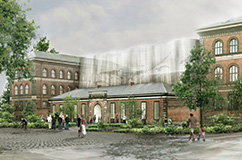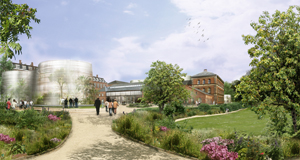Christmas present of the year: 550 m from private foundations ensures new museum of natural history.
Through generous donations from VILLUM FONDEN, The Novo Nordisk Foundation, The Obel Family Foundation and the Aage and Johanne Louis-Hansens Foundation, the University of Copenhagen is now able to build the new Natural History Museum of Denmark. Together the four foundations have contributed 550 m Danish kroner to the project, which will cost 950 m to construct.

The people who merely pass by the museum will get a small musum experience at no expence. At the top of the glass roof, a colossal whale skeleton floats, visible from a distance both night and day.
Click on the image for a larger version.
The new Natural History Museum of Denmark will be located within the Botanical Garden in the heart of Copenhagen. The project will join the Zoological Museum, the Geological Museum, and the Botanical Museum in an international world-class museum. From 2020, giant whales, exotic plants and rare meteorites will be on display, as well as the museum’s newest inhabitant, the dinosaur Misty. The firm Lundgaard & Tranberg architects and architect Claus Pryds have designed the museum.
- With these generous gifts from the foundations, the University of Copenhagen has a unique opportunity to strengthen our work within outreach, research and education. We decided to join our three museums of natural history back in 2004. We now celebrate the results of a ten-year effort and I am very grateful for the support we have received throughout the entire project, says rector Ralf Hemmingsen.
One dino, 50 whale species and numerous other precious treasures
Once the new museum opens its doors, it will house one of the 10 largest collections of natural history in the world. The more than 14 m objects cover a broad range: You can meet the loneliest spider in Denmark. Only one specimen has been found in Denmark and has never been found since, anywhere in the world. You can visit the world’s largest and most complete collection of whale skeletons. And you can learn more about the ancient meteorites of our Solar System. The Botanical Garden will also play an important part in the museum experience of tomorrow.

The new natural history museum will be gently placed within the botanical garden.The historical buildings will be preserved and will be interconnected through glass buildings and greenhouses, that elegantly unify the old and the new.
Click the image for a larger version.
- Being so close to the Botanical Garden is part of what will make the new museum so unique. There are very few places in the world where you can explore all of nature in one museum. We have now succeeded in creating a one-of-a-kind and meaningful experience in the middle of Copenhagen and that is fantastic, says museum director Morten Meldgaard.
Already today, the Natural History Museum of Denmark houses four significant and internationally renowned research centres and serves as the daily workplace for a number of the university’s top scientists. The museum’s school service is one the strongest in the country, and when the new museum opens, 55.000 students will use the new facilities annually. The amount of visitors to the museum will triple to more than 400.000 a year.

Cross section of the new museum. The many exhibitions are below the surface.
Click the image for a larger version.
- The new museum is important in our efforts to continue to be at the forefront of scientific research. It is also an important part of the food chain within scientific education. Today, nature – and consequently the living conditions of man – change so very rapidly. Therefore we have to be where it happens and contribute to the understanding of nature and pass on important new knowledge to present and future generations, says museum director Morten Meldgaard.
Financing
- 250 m VILLUM FONDEN
- 100 m the Obel Family Foundation
- 100 m the Novo Nordisk Foundation
- 100 m the Aage and Johanne Louis-Hansens Foundation
- 300 m the University of Copenhagen
- 100 m the Danish Government
Contact
Senior executive consultant Charlotte Autzen
University of Copenhagen
Phone: +45 28 75 42 64
Head of Communications Rikke Mørch
Natural History Museum of Denmark
University of Copenhagen
Phone: +45 30 50 66 21
Contact
Jasper Steen Winkel
Director of Communications
University of Copenhagen
Mail: jsw@adm.ku.dk
Phone: 28 75 42 62
Charlotte Autzen
Senior executive consultant
University of Copenhagen
Mail: chau@adm.ku.dk
Phone: +45 28 75 42 64
Rikke Mørch
Head of Communications
Natural History Museum of Denmark
University of Copenhagen
Mail: rsm@snm.ku.dk
Phone: +45 30 50 66 21
Timeline
2004: Organisational
2009: Idea competition
2012: Architect competition
2014: Final project and financing
Funded by:




Facts about the new museum
When the doors to the new museum open, the number of visitors will increase from 150.000 to 400.000 annually.
Over a period of ten years, the share of tourists of the total number of visitors will increase from 2% to 33%.
Visits from schools and upper secondary schools are expected to increase from 19.000 in 2013 to 55.000 when the new museum is ready.
The new exhibitions, Precious Things at the Zoological Museum, joins geology, botany and zoology, and points towards the new Natural History Museum of Denmark.
Photos
The photos on this site must be used in conjunction with media coverage of the story. Click on the photos to download them in high resolution. Please credit The Natural History Museum of Denmark.
